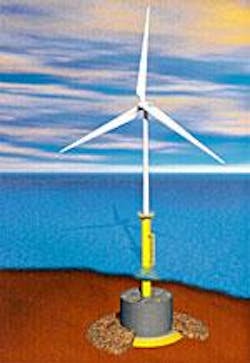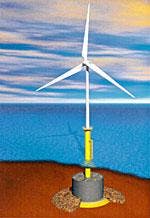FRANCE: Self-installing wind turbine limits costs, provides improved stability
Jacques Ruer, Edmond Coche, Geraldine Jego,Bouygues Offshore
Increasing numbers of offshore wind projects are going forward around the world, mainly in European waters. To counterbalance the costs associated with installation offshore, the trend is to design new turbines with a nominal power output far exceeding that of conventional turbines used on land. Over the past five years, capacity of the most powerful machines has risen from 1 mw to 2.5 mw, and 5 mw or larger versions are under study.
Compounding the difficulty of offshore projects is the water depth, typically 20-30 m for installations planned off northern Europe. Support structures for the turbines have to be designed accordingly. At the same time, the offshore contractors are being asked to build and install many huge and delicate machines economically, far from a harbor, in seas where harsh wind and wave conditions can occur.
For the offshore wind projects undertaken so far, installation of the support structures and the turbines has been performed separately, replicating the approach for such installations onshore. Typically, a 2-mw turbine would be installed on a monopile in 30 m of water, with a 350-ton steel tube foundation, 80 m long, driven 40 m into the seabed. The turbine tower would be around 50 m high, with a weight of 120 tons.
The conventional lifting facilities for structures of this size are floating cranes, or jackup barges equipped with cranes. Floating cranes are used to install heavy modules onto supporting structures. Although some are equipped with active control systems that limit the load's movements, it is not possible to avoid completely a relative motion by the load above the support. So the use of floating cranes for erecting wind turbines is only feasible during calm weather. Also, the cost of floating cranes may be too high for some wind projects.
Jackup cranes have several legs that can be lowered onto the floor. The platform is then raised above sea level and subtracted to the wave action. This replicates the stable conditions associated with onshore installations. However, only a few jackup barges have the lifting force and height required for the 2-mw class turbines, and almost none will be able to satisfy the demands of future giant turbines.
Some contractors have responded by building completely new vessels, designed specifically to install the wind farms currently under development in northern Europe. However, the lift capacities of these vessels will again have to match the size of future turbines.
Another approach could be to modify existing jackup crane barges to accommodate cranes with longer booms. One such barge is Bouygues Offshore's JUP III, currently based in the Gulf of Guinea, which is 60 m long and 30 m high above water, with 68-m legs. The JUP III's crane can perform lifts of up to 200 tons in 50 m water depth, but the crane could be upgraded for loads of 250-300 tons. The vessel can also work in waves of up to 1.5 m during jacking operations.
SeaFlower
Bouygues Offshore recently performed a prospective study concerning an in-house offshore wind turbine design and associated installation method. An integrated approach was adopted, with installation of the foundation and the wind turbine considered together. The aim was to optimize the installation work to be performed at sea, and also to reduce the associated costs. The result of this study was a new concept of self-installing turbine, called SeaFlower.
The SeaFlower system comprises essentially:
- A gravity base formed from a concrete caisson filled with ballast
- A telescopic tower supporting the nacelle.
The caisson design must satisfy two main criteria. First, it must guarantee stability for the turbine throughout the wind farm's life. This means it must be able to resist wind, wave, and current loads, taking into account the following criteria:
- No overturning or sliding, even under the most hostile conditions
- Acceptable vertical loading on the ground compared to the seabed-bearing capacity.
The caisson's inner volume is filled with ballast, i.e., sand, to obtain the required weight.
Second, the system has to be designed to ensure safe towing and subsequent immersion. This is achieved via a telescopic mast that lowers the SeaFlower's center of gravity, thereby improving stability during tow-out.
Calculations show that the size of the caisson results from the first function. No added volume is required for vertical stability during flotation due to the low position of the center of gravity when the telescopic tower is retracted.
Construction and installation
There are three main phases for construction and installation:
- Onshore construction of the caisson and assembly of the wind turbine
- Soil preparation at the wind turbine's offshore location
- Towing and installation.
Caisson construction is performed on a production line at an onshore point close to the site of the wind farm. At the first station, the bottom slab is concreted, with concreting of the walls to follow at the subsequent stations. To optimize the speed and cost of the process, the assembly line can be adapted to the project's specific conditions, i.e., number of caissons, available ground surface, launching method.
Next, the caisson is launched into the sea using a slipway or another preferred technique. The caisson is then towed alongside a quay where the ballast needed for stability during the towing phase is loaded. Following these steps, the telescopic mast, nacelle, and blades are assembled, and a cofferdam used for the immersion phase is installed. The caisson is then towed to its final location.
At the wind turbine site, soil is prepared and leveled. Bouygues Offshore has developed a leveling system that simplifies this phase. The caisson is moored to enable close control of its position during immersion. Next, the caisson is filled with water and immersed. During the descent, the cofferdam provides the required stability. It can also be used for reversing the process. Support operations are provided by a pontoon bearing the pumping equipment and the handling system for the cofferdam.
Lastly, solid ballast is poured into the caisson. The cofferdam is removed, with a scouring protection placed around the base, and the nacelle is then raised to its final position.
Bouygues Offshore performed a study of the SeaFlower concept in water depths of 19 and 30 m, based on a 2-mw turbine. In both cases, the system emerged as competitive compared to a traditional monopile solution. More work has to be done onshore during the construction phase, but there is much less work associated with the offshore installation. This should increase confidence in scheduling and costs, as onshore works are generally easier to control than those offshore.
The SeaFlower also presents other potential benefits:
- Jackup barge or floating crane is needed for the installation, limiting the cost of the operation at sea and the problem of offshore vessel availability
- The operation offshore is reversible. Should the blades need to be replaced, the nacelle can be lowered to ease the operation.

